Non-disclosure agreement (NDA)
What is a non-disclosure agreement?
A non-disclosure agreement (NDA) is a legal contract between two or more parties that outlines the handling of confidential information or trade secrets, ensuring the data is not disclosed to any unauthorized third parties.
What is the purpose of a non-disclosure agreement?
The primary purpose of an NDA is to protect confidential information. When businesses or individuals collaborate, they often need to share sensitive details with each other. An NDA ensures that these disclosures are safeguarded from misuse, theft, or public exposure.
Beyond protection, an NDA serves several key functions:
- Establishes clear boundaries around what information is confidential
- Prevents unauthorized use or sharing of sensitive data
- Provides legal recourse if the terms are breached
- Fosters an environment of trust and transparency
What are the three types of non-disclosure agreements?
Unilateral NDA
A unilateral NDA involves two parties, where one party shares information and the the other party agrees to keep it confidential. This is commonly seen in employment contracts.
Bilateral NDA
A bilateral NDA refers to a situation where two parties involved in the agreement share confidential information with each other and agree to protect each other's interests. This type of agreement works on collaborative projects, joint venture discussions, and more.
Multilateral NDA
A multilateral NDA involves three or more parties, with at least one sharing confidential data. This format simplifies the process by consolidating obligations into a single agreement, rather than requiring multiple NDAs between each party.
What kind of information does an NDA cover?
NDAs typically cover any information that is not publicly known and is valuable to the disclosing party. This can include:
- Business plans or marketing strategies
- Customer and vendor lists
- Financial records and forecasts
- Product designs, specifications, or prototypes
- Technical data, algorithms, or software code
- Trade secrets and proprietary methods
What should be excluded in an NDA?
- Information already in the public domain (unless made public through a breach)
- Details already known to the receiving party before the agreement
- Data independently developed by the receiving party without using the confidential information disclosed under legal or regulatory obligations
- Anything the disclosing party later agrees can be shared
What are the advantages of having an NDA?
- Provides a legal framework for confidentiality
- Encourages openness and collaboration between parties
- Reduces the risk of intellectual property theft
- Can be customized to fit a wide range of use cases
What are the disadvantages of having an NDA?
- Enforcement can be complex, especially across jurisdictions.
- Vague or overly broad terms may be challenged in court.
- The use of such agreements may create tension if it's perceived as a lack of trust.
- In some contexts, it might limit employee mobility or innovation if misused.
What happens when you disclose an NDA?
Breaking an NDA can have serious consequences. The specific penalties usually depend on what’s written in the agreement, but they often include:
- Injunctions to stop further disclosure or use of the information
- Financial damages to cover any losses the breach caused
- Termination of contracts or employment
- In rare cases, legal action that leads to court-ordered penalties
Do NDAs expire?
Yes, most NDAs include a time frame for how long the confidentiality must be maintained. It could be one year, three years, five years—it really depends on the nature of the information and the industry. In some cases, especially with trade secrets, the NDA might not expire at all.

